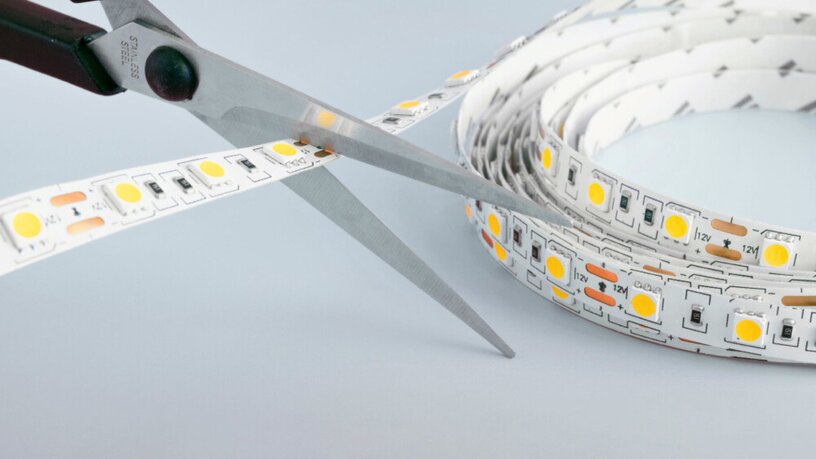Trade Members Get 10% Off. Sign Up Today

LED Lighting Basics
General Technical Information
LED (Light Emitting Diode) lighting represents a major advancement in energy-efficient technology.
Unlike traditional incandescent or halogen bulbs, LEDs generate light through electroluminescence — a process where electrical current passes through a semiconductor material, producing visible light. This means no filaments to burn out, no warm-up time, and significantly lower energy consumption.

Light Output
Light output in LEDs is measured in lumens, not watts. Higher lumen values indicate a brighter light. Unlike incandescent bulbs, LEDs use far less power to produce the same amount of light, making lumen measurement essential for selecting the right product for your needs.
Lumens
Lumens (lm) are the standard unit of measurement for the total quantity of visible light emitted by a source. For example, a typical 60W incandescent bulb produces about 800 lumens, while an LED equivalent or strip, may only use 9W to achieve the same brightness.
Voltage
Our LED products are available in a variety of voltage options, including low voltage (e.g., 12V 24V or 48V DC). Always ensure you're using a compatible driver or power supply, especially when installing low-voltage LEDs. Learn more about how voltage drop works here.
Current
Current refers to the flow of electric charge through a circuit, and in LED systems, it’s a critical factor that directly affects both performance and lifespan.

Why Current Matters
LEDs (Light Emitting Diodes) are current-driven devices, which means their brightness and efficiency depend heavily on how much current flows through them. This current is measured in Amperes (A).
- Too Much Current: Can cause the LED to overheat, degrade faster, and ultimately fail.
- Too Little Current: Results in underperformance — your LED may be dim or unstable.
How Current is Controlled
To maintain a safe and consistent flow, LED circuits often include components like:
- Resistors: These limit the current passing through the LED.
- Drivers: These regulate voltage and current, especially in more advanced or high-powered LED systems.
Read our article on Constant Voltage VS. Constant Current LED Systems here.

Key Takeaways For Customers
- Always use recommended power supplies and drivers that match your LED specifications.
- Never bypass current-limiting components unless you're using a built-in current-regulated module.
- For long-lasting LEDs, maintaining the right current level is as important as choosing the right LED.
CAD And Data Sheet Downloads
All datasheets for our products are available directly on our website. Simply visit the product page of the item you're interested in, and you’ll find a link to download the datasheet in PDF format. These datasheets include detailed specifications, technical information, and installation guidelines to help you make informed decisions.
If you need further assistance locating a datasheet, feel free to contact our support team — we're happy to help!

Compatibility
Please note that while we can and do advise on compatibility of our own products we cannot advise on compatibility of products sourced from us with products sourced from elsewhere or on how things should be installed.
All installations should be planned and installed under the supervision of an appropriately qualified electrician, sourced by you, who takes responsibility for product selection and installation.
We accept responsibility and liability only to our customers and only in accordance with the foregoing exclusion/limitation and those set out in applicable terms of business. Any comment offered on other matters, or to non-customers (e.g. pre sales enquiries), is offered on a strictly non-reliance/no liability basis.

Are Your Products Compatible With My Existing Lighting Setup?
At Ultra LEDs, we design our products to be compatible with a wide range of lighting systems and applications.
However, compatibility can depend on a few key factors, including:
- Voltage Requirements: Make sure the power supply matches the voltage rating of the LED product.
- Dimmers & Controllers: If you're using dimmable LEDs, check that your dimmer or controller is compatible with LED technology. Some older or traditional dimmers may not work effectively with modern LED products.
- Connectors & Fittings: Many of our products use standard fittings and connectors, but we always recommend reviewing the product specifications or datasheets (available on each product page) to ensure a proper fit.
- Indoor vs. Outdoor Use: Products designed for indoor use may not be suitable for outdoor environments. Please check IP ratings for water and dust resistance if you're planning an external installation.
If you're unsure whether a specific product will work with your setup, our expert support team is happy to help.
You can contact us with details about your existing installation, and we’ll provide guidance on the most suitable products and accessories. ext...
Author: Tom Cain, Technical Manager @ Ultra LEDs
Tom brings years of hands-on experience in professional LED lighting solutions, specialising in product development, system integration, and lighting control technologies. As Technical Manager at Ultra LEDs, he supports the team with in-depth knowledge across LED drivers, dimming protocols, and complex installations. His expert insights help ensure our content is accurate, relevant, and grounded in real-world applications.
Get in touch with Ultra LEDs today
From high-CRI strip to RGBW tape and horticultural lighting, our full range includes spectrum-tested solutions with downloadable SPD data. Explore the range or speak to our team for specification advice.





